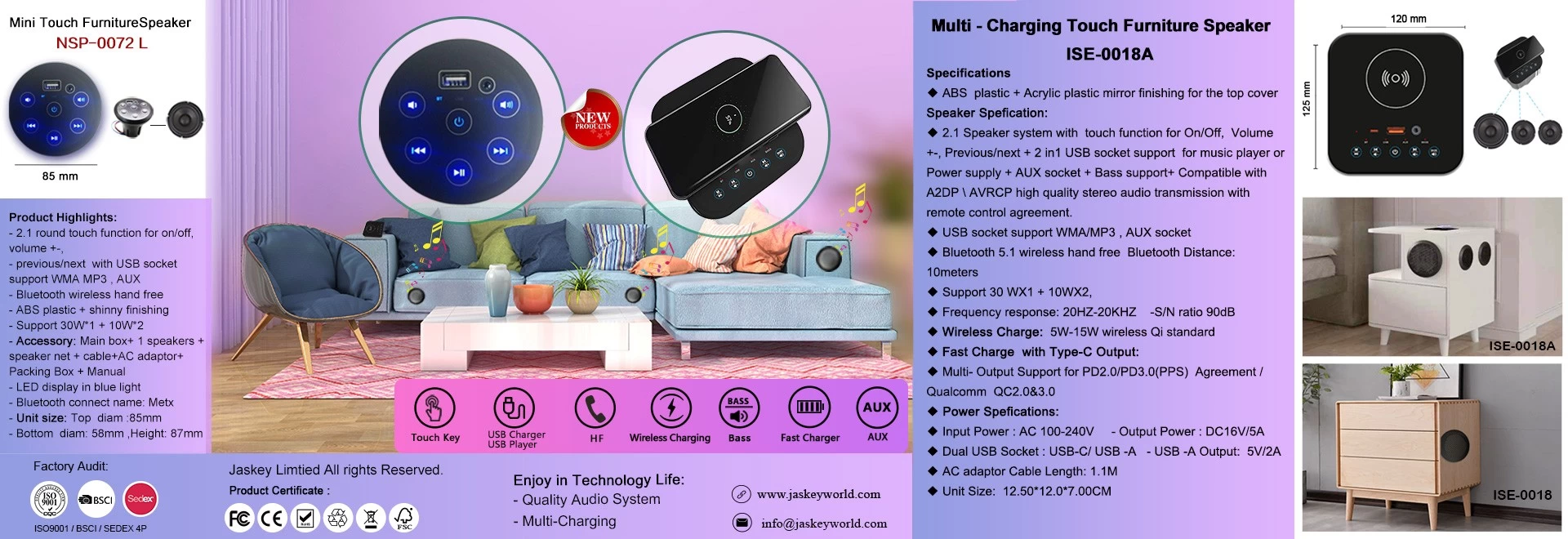Damping coefficient of the power amplifier
What is the damping coefficient
Damping coefficient refers to the rated load amplifier (mini hifi speaker) impedance and the ratio of actual impedance of power amplifier., the internal resistance of it represent the power output of the mini hifi speaker of the damping effect index of less.
Damping coefficient of general use DF (that is, the Damping Factor), DF = Rs/Ro, Rs is the mini hifi speaker's internal resistance, Ro is the amplifier's output impedance.The less the DF, the greater the distortion.
We know that the mini hifi speaker (including headphones) after excitation vibration, even if the excitation signal stopped, the vibration of the speaker will not stop immediately, but gradually attenuation vibration and eventually stop, on the back of the excitation signal interference.At the same time in the process, because of the voice coil cutting lines of magnetic force, make the mini hifi speaker itself into a power source, form and the internal resistance of the power amplifier circuit and generate an electric current, the current under the action of magnetic field, have the opposite force, make the process of vibration attenuation become smaller (that is, produce damping).Obviously, the smaller the internal resistance of the power amplifier, mini hifi speaker attenuation process is shorter, the smaller the distortion.
The definition of damping coefficient
Damping coefficient, (Damping Factor) refers to the rated load of the power amplifier, mini hifi speaker impedance and the ratio of power amplifier actual impedance.Small damping coefficient large said amplifier output resistance, damping coefficient is amplifier in the signal disappeared after the ability of controlling the movements of the speaker cone.Amplifier with high damping coefficient for the mini hifi speaker is more like a short circuit, the signal termination can reduce the vibration.Power amplifier output impedance will directly affect the mini hifi speaker system low Q value, which affects low frequency characteristics of the system.The Q value of the speaker system is unfavorable and exorbitant, generally within the range of 0.5 ~ l is good, the output impedance of power amplifier is the factor to low Q value rise, therefore generally want power amplifier output impedance is small, good damping coefficient greatly.Damping coefficient between tens to hundreds of commonly, the high quality professional power amplifier of damping coefficient can be as high as more than 150-200.
Damping coefficient analytical
One of the specifications of the power amplifier
Damping coefficient is one of the parameters of the power amplifier, it directly affect the handling of power amplifier for mini hifi speaker system.Damping coefficient data provided by the general power amplifier and released only a certain frequency of damping coefficient.
Not the higher the better
The complexity of the relationship between the mini hifi speaker and amplifier power supplement principle is a basic and sensitivity, and between current and horn is more unpredictable, can't can be judged from the specification table, only by experience and with ears to hear.In addition to current can't grasp, and as is the Damping coefficient, Damping Factor).
Damping coefficient does not represent the damping force.Horn (amp) maximum damping force when it is short circuit, for a limited value.The short circuit Q value of the corresponding horn.Again big damping coefficient is infinitely close to this value.For example;The damping coefficient of 10 to 90%, 100 99%, 1000 99.9%, so the damping coefficient is not necessary to too much.Negative feedback is the damping coefficient of the decisive factor, excessive damping coefficient for the depth of the negative feedback, will bring many negative effects.So, different damping coefficient of the amplifier sample, cannot be simply explained by damping coefficient, because in fact has no difference between 99% and 99.9%.
Different spectrum will change
Damping coefficient is one of the parameters of the power amplifier, it directly affect the handling of power amplifier on the horn.Damping coefficient data provided by the general power amplifier and released only a certain frequency of damping coefficient.
But in fact most of the damping coefficient of the power amplifier, will change in different frequency band, so the data can only be provided as a about instructions.Some mini hifi speakers need high damping coefficient to control the speaker unit, if deserve to go up the insufficient damping power amplifier,mini hifi speaker unit will be out of control, a redundant harmonic vibration and from loss.
Damping coefficient of the match
Damping coefficient KD is defined as: KD = rated power amplifier output impedance (equal to rated speaker impedance)/power amplifier output impedance.Because of the power amplifier output impedance in fact has become a mini hifi speaker electrical damping device, KD value decided the mini hifi speakers damping quantity of electricity.KD value, the greater the electrical damping quantity is heavier, amplifiers, of course, the KD value is not the bigger the better, the KD values will make the speaker electrical damping is overweight, so that make the pulse front set up time, reduce the index of transient response.So when selecting amplifier should not be one-sided pursuit of large KD values.As household high-fidelity amplifier damping coefficient have a experience for reference, the minimum requirements: transistor amplifiers KD values greater than or equal to 40, vacuum tube amplifiers KD values greater than or equal to 6.
Damping coefficient is not one of the important electric index of power amplifier, published in 2002, the ministry of information industry audio association of high-fidelity amplifier, there is no the index in the index detection requirements.










